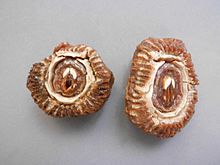| Cryptolepas rhachianecti | |
|---|---|
 | |
| Scientific classification | |
| Domain: | Eukaryota |
| Kingdom: | Animalia |
| Phylum: | Arthropoda |
| Class: | Thecostraca |
| Subclass: | Cirripedia |
| Order: | Balanomorpha |
| Family: | Coronulidae |
| Genus: | Cryptolepas |
| Species: | C. rhachianecti |
| Binomial name | |
| Cryptolepas rhachianecti | |
Cryptolepas rhachianecti is a species of whale barnacle that lives as a passenger on the skin of gray whales and certain other species of whale in the northern Pacific Ocean.